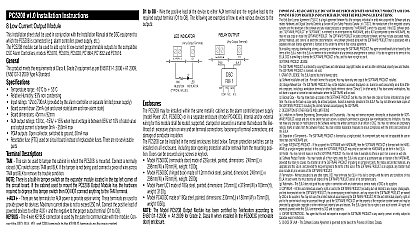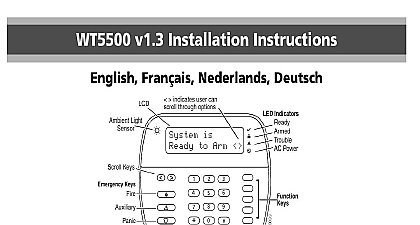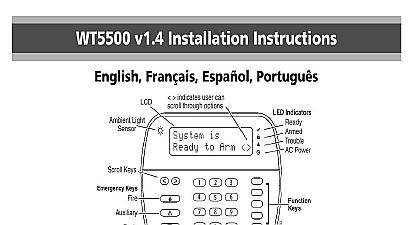DSC Install Instructions - SS-102 - Eng - Fre - Spa - Chi

File Preview
Click below to download for free
Click below to download for free
File Data
| Name | dsc-install-instructions-ss-102-eng-fre-spa-chi-0893621547.pdf |
|---|---|
| Type | |
| Size | 3.59 MB |
| Downloads |
Text Preview
3301 Langstaff Road Ontario Canada 4L2 905 760 3000 SS 102 Installation Instructions English Shockgard SS 102 electronic shock sensors have been designed utilizing the most advanced microchip technology to provide effective false alarm resistant protection Shockgard SS 102 series offers a wide range of features including remote LED reset first to latch indication and subsequent to alarm latch Other features include automatic relay reset and dual stage linear sensitivity adjustment by selection offering a broad band sensitivity control Selectable pulse count and dual colour LED information provides the installer with everything he requires for this of detector output is provided by a pair of non latching normally closed relay contacts opening for a minimum of 1 second on detection of an This relay is normally energized to give fail safe operation in the event of a power loss is provided by a LED situated on the front cover On board circuitry allows for the selection of momentary or latching indication automatic LED inhibit feature is also included Latch enable and reset may be remotely controlled by standard control panel signals unit is fully protected from tampering by a N C switch operated by removal of the cover Moisture repelling rubber grommets are with the Shockgards Refer to Fig 1 2 12V power connection reverse polarity protected 4 N C Alarm output contacts with 10 ohm resistor in series T6 N C Anti tamper contacts Connection for 12V remote latch control signal usually SET or SW control equipment signal 1 3 T6 2 3 4 5 6 7 6 1 12V 0V ALARM CIRCUIT LATCH TERMINAL 12V SET SW ANTI TAMPER NOT USED SENSITIVITY SELECTION LEVEL Low High LATCH RESET SWITCH PULSE COUNT SELECTION SWITCHES SENSITIVITY ADJUSTMENT ANTI TAMPER SWITCH using the sensor in momentary mode it will usually be necessary to connect using a 6 core cable If the latch facility is being used additional core will be required for the connection of the latch terminal OF OPERATION all modes of operation the N C alarm contacts are non latching Upon alarm activation the alarm contacts will open circuit momentarily for a time of 1 second before automatically resetting latch terminal unconnected LED will illuminate when the alarm contacts are open circuit in response to an input signal Indication During the sensitivity test procedure indication of the green LED denotes alarm and relay operation Indication of the red LED vibration detected pulse but insufficient to create alarm conditions stage linear sensitivity The detector permits the installer a greater threshold of sensitivity adjustment by selection of the potentiometer through either a low level or high level adjustment When DIP Switch 5 is in the On positition the potentiometer allows adjustment in the high sensitivity area and when in the Off position the sensitivity potentiometer allows in the low sensitivity area 12V applied to latch terminal When 12V is applied to the latch terminal the LED is inhibited Upon removal of the 12V signal the LED indicate the status of the latch i e if the unit has detected an alarm the LED will be permanently flashing amber otherwise the LED will in momentary mode Reapplication of the 12V signal will reset the latch and extinguish the LED to Latch 12V applied to latch terminal via a 47k resistor See fig 2 Operates as in latching mode with the exception that only the unit to detect an alarm will latch with a flashing LED Any subsequent detector to alarm will indicate with a steady LED operation 6 wire Should the Shockgard SS 102 be wired in a 6 wire configuration latch reset can be achieved by selection of the switch of the DIP Switch unit With this switch in the position and the Shockgard SS 102 activated in full alarm the LED will on with the LED flashing amber until the supply voltage is interrupted when the Shockgard SS 102 will reset latch reset can be achieved by using a seven wire configuration with the latch reset wire connected with terminal 7 on the terminal block device complies with Part 15 of the FCC Rules Operation is subject to the following two conditions This device may not cause harmful interference and 2 this device must accept any interference received interference that may cause undesired operation Class B digital apparatus meets all requirements of the ICES 003 appareil num de la classe B respecte toutes les exigences du ICES 003 count and latch operation series of 6 switches are situated below the main terminal block for pulse count selection sensitivity selection and operation of latch when a six wire configuration The first three switches i e 1 2 and 3 are designated for pulse count Selection as follows For pulse count two Switch No 1 to position Switches 2 and 3 to For pulse count four Switch No 2 to position Switches 1 and 3 For pulse count six Switch No 3 to position Switches 1 and 2 For no pulse count Switches 1 2 and 3 in off position 4 See Latch Operation 6 Wire paragraph 5 Enables Sensitivity adjustment High Low 6 Not used prosedure of pulse count selection of number pulse counts required and adjustment of sensitivity level tap the area of coverage allowing a few seconds between each After each tap the LED will indicate red colour mode confirming receipt of vibration and pulse received On completion of pulses selected the SS 102 will activate the relay and the LED will confirm activation by illumination of a green LED In the event of gross attack the will disregard the pulse count memory and activate the relay and illuminate green LED indication PROCEDURE Select the intended position for installation ensuring the surface is clean and clear of any irregularities Remove the cover of the sensor by unscrewing the single captive screw until the cover can easily be removed from the base Carefully lift the printed circuit board from the base Present the base to the mounting position and mark the desired fixing holes If rear cable entry is required cables should be threaded through the rear of the base Fix the base in position using the screws provided or pin nails if preferred some hard surfaces may require pilot drilling Carefully push the printed circuit board onto the base Make the electrical connections to the Shockgard SS 102 If side cable entry is being used remove the appropriate knockout from the cover and put in a grommet Setting up and adjustment With the unit in momentary operation See modes of operation Dual stage linear sensitivity Use a terminal screw to turn the sensitivity control See fig 1 fully clockwise to maximum Position 6 Using a suitable implement bang or tap the protected observing the LED response Reduce the sensitivity by a small amount turn sensitivity control anti clockwise and bang or tap the protec area Repeat this process until the unit only just responds to the desired impact Replace the cover of the sensor tighten the fixing screw and check its response to the desired impact Unit Connection Procedure 2 NOT FIT THIS RESISTOR IF USING ANY TO LATCH VOLT VOLTS VOLT RANGE Wall m m m m m m m All values quoted are typical and are subject to practical testing which must be made for each installation In some environments attenuation may be very high DATA Voltage quiescent alarm limit humidity at 30 setting Non Latching mm Contact Rating relay open in alarm count No of units on any Latch No of units on 1st to Latch DC maximum maximum flashing LED 27mA to 60 stage potentiometer subsequent or any 6 wire colour LED x 23 x 85mm 24V resistive 10 Ohm 1 4 Watt second minimum 4 or 6 4 5 6 D SHOCKGARD SS 102 Made in Israel 2 4 T6 1 12V


